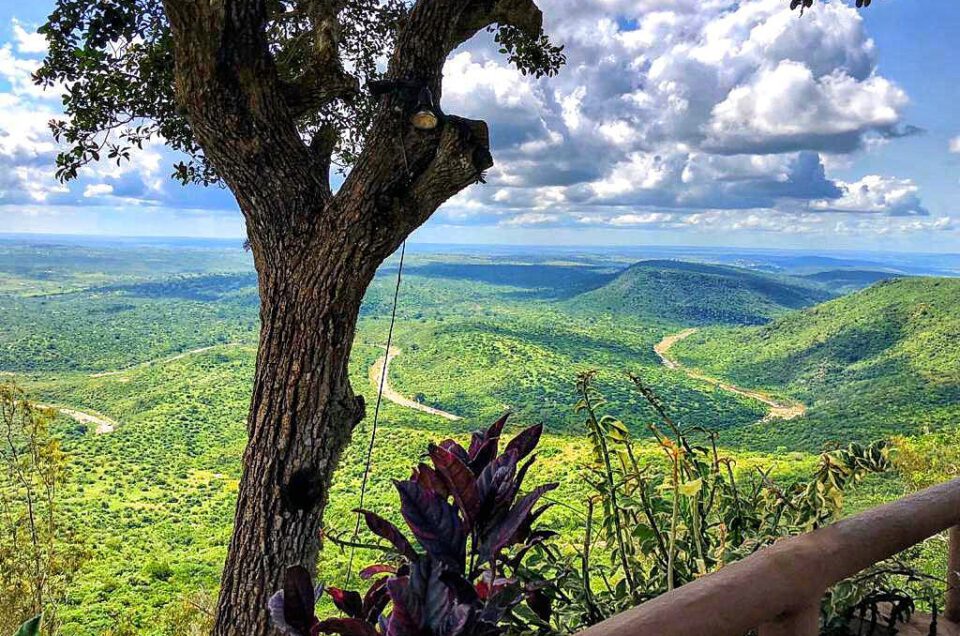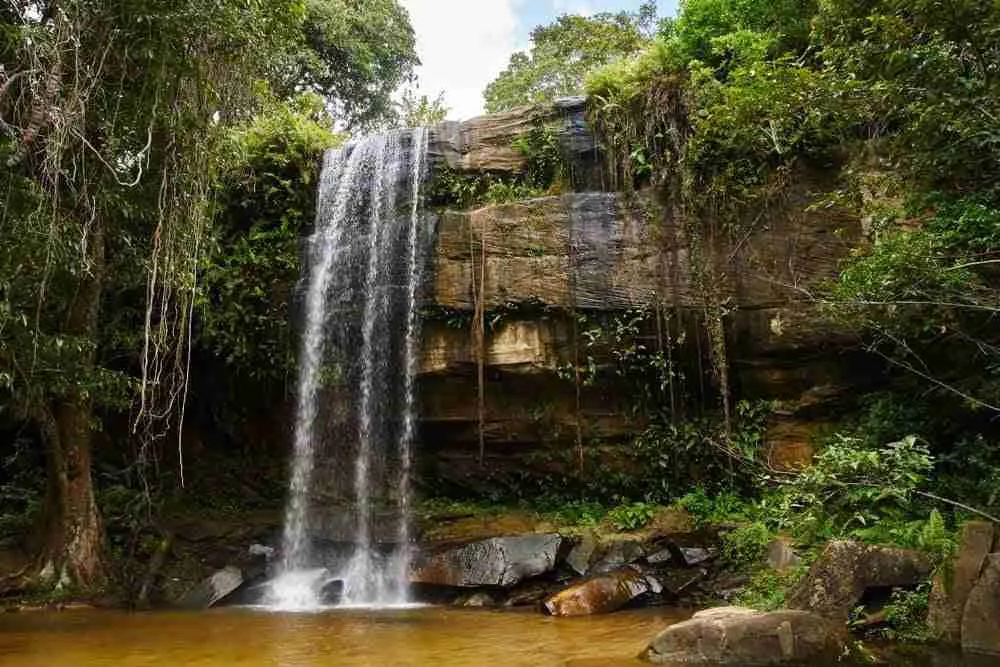Introduction to Shimba Hills
Nestled just 33 kilometers from Mombasa and a short drive from the famous Diani Beach, Shimba Hills National Reserve is one of Kenya’s most underrated treasures. Unlike the vast savannah parks such as the Maasai Mara or Tsavo, Shimba Hills is unique because it combines dense coastal rainforest, rolling green hills, and open grasslands, all within a compact area of about 300 square kilometers. This diversity makes it a haven for wildlife, plants, and bird species that are rarely seen in other parts of Kenya.
Where is Shimba Hills Located?
Shimba Hills lies in Kwale County, along the southern coast of Kenya. It forms part of the greater coastal ecosystem that includes mangroves, coral reefs, and beaches. The reserve is situated on a plateau that rises to over 450 meters above sea level, providing sweeping views of the Indian Ocean. For travelers in Mombasa or Diani Beach looking for a quick safari experience without venturing deep into the country, Shimba Hills is the perfect choice.
Why Shimba Hills is Special
What sets Shimba Hills apart is its unique blend of coastal rainforest and savannah ecosystems. It is home to the last remaining population of the rare sable antelope in Kenya, which cannot be found in other parks across the country. The park is also known for its large elephant population, estimated to be over 500, as well as Sheldrick Falls, a spectacular 25-meter waterfall hidden deep within the forest. Shimba Hills is not only a wildlife paradise but also a sanctuary for biodiversity and a place where visitors can enjoy the serenity of nature without the crowds often found in other safari destinations.
History and Cultural Significance of Shimba Hills
The history of Shimba Hills goes beyond its designation as a national reserve. It has deep cultural significance to the local communities who have lived in the area for centuries.
The Origins of Shimba Hills National Reserve
Shimba Hills was gazetted as a national reserve in 1968 to protect its fragile ecosystem and unique wildlife. Before this, the forest and hills served as a natural resource base for the Digo people, who practiced farming, hunting, and traditional medicine collection. The creation of the reserve was crucial in conserving the sable antelope, which had been rapidly declining due to habitat destruction and poaching.
Cultural Heritage of the Digo People
The Digo, one of the Mijikenda sub-tribes, have lived in the Shimba Hills region for generations. The forest was not just a source of livelihood but also a spiritual place. Sacred sites, shrines, and rituals were often conducted in certain parts of the forest. Traditional healers relied heavily on the medicinal plants found in Shimba Hills, many of which are still in use today. Even after the establishment of the reserve, the cultural connection between the Digo people and the land remains strong, with community projects being developed to support both conservation and cultural preservation.
Geography and Landscape of Shimba Hills
Shimba Hills is one of the most geographically diverse reserves in Kenya. Unlike the flat plains of the Maasai Mara or Amboseli, Shimba Hills offers rolling hills, escarpments, valleys, and patches of forest.
Unique Topography and Climate
The reserve sits on a plateau with an average elevation of 300–450 meters. This higher altitude gives Shimba Hills a cooler and more refreshing climate compared to the hot and humid coastal strip. Temperatures range between 20°C and 30°C, making it an ideal escape from the coastal heat. The hills also act as a watershed, with rivers flowing into the Indian Ocean and supporting local agriculture.
Waterfalls and Rivers in the Reserve
One of the most striking features of Shimba Hills is Sheldrick Falls, a 25-meter cascade that plunges into a natural pool. This waterfall is accessible via a guided nature trail that takes about 2 hours. Apart from Sheldrick Falls, several rivers such as the Marere and Kivumoni cut across the reserve, creating lush valleys and providing water for wildlife. These rivers eventually flow into the Indian Ocean, sustaining both people and ecosystems along the way.
Coastal Forest Ecosystems
Shimba Hills is recognized as one of the largest coastal forests in East Africa, second only to the Arabuko Sokoke Forest near Malindi. This forest type is extremely rare and rich in biodiversity, with species of trees and plants that cannot be found anywhere else in Kenya. The dense vegetation provides shade, moisture, and habitat for countless animals, making Shimba Hills one of the most ecologically valuable reserves in the region.
Wildlife in Shimba Hills
For wildlife lovers, Shimba Hills is a paradise waiting to be discovered. Despite its relatively small size, it harbors an impressive range of animals.
Elephants – The Iconic Residents
Shimba Hills is home to over 500 elephants, making it one of the densest elephant populations in Kenya. These elephants are often seen grazing in the open grasslands or moving in herds along the forest edges. Because of the high elephant numbers, human-wildlife conflict has sometimes occurred, which led to the creation of the Mwaluganje Elephant Sanctuary as a corridor for safe elephant migration.
Rare Species – The Sable Antelope
The most famous resident of Shimba Hills is the sable antelope, a majestic animal with curved horns and a striking black coat. Shimba Hills is the only place in Kenya where this species can still be found, making it a must-see for safari enthusiasts. The presence of the sable antelope alone makes Shimba Hills an important conservation area not just for Kenya, but for the entire East African region.
Birdlife and Butterflies
With over 200 recorded bird species, Shimba Hills is a birdwatcher’s paradise. Species such as the Fischer’s turaco, the African hawk-eagle, and the trumpeter hornbill are commonly spotted. The reserve is also known for its colorful butterfly populations, which thrive in the forested areas and add a magical touch to nature walks.
Flora of Shimba Hills
Apart from wildlife, Shimba Hills boasts a spectacular variety of plants and trees that make it one of Kenya’s most botanically diverse regions.
Rare Plant Species
The reserve is home to several endangered plant species, including cycads, orchids, and unique ferns. Some of these plants are endemic to the area, meaning they are found nowhere else in the world. Botanists often visit Shimba Hills to study these rare species, making the reserve important not just for tourism but also for scientific research.
The Coastal Rainforest Vegetation
The thick rainforest canopy in Shimba Hills creates a cool, damp environment where massive trees tower above. Lianas and creepers dangle from branches, while the forest floor is covered in thick undergrowth. This vegetation provides critical cover for animals and plays a role in carbon storage, making it vital for combating climate change.
Medicinal and Indigenous Plants
Local communities have long depended on Shimba Hills for traditional medicine. Plants like the African myrrh tree, wild basil, and aloe are commonly used for healing purposes. Even today, herbalists and healers from the Digo community continue to gather medicinal plants from the reserve, preserving centuries-old knowledge of natural remedies.
Tourist Attractions in Shimba Hills
Shimba Hills is not just about wildlife; it is also a destination filled with breathtaking attractions that appeal to both adventure seekers and nature lovers.
Sheldrick Falls
One of the highlights of Shimba Hills is Sheldrick Falls, a stunning 25-meter waterfall hidden deep in the forest. The trek to the falls is a guided walk of about two kilometers, winding through lush vegetation alive with birdsong and butterflies. At the bottom, the cool, cascading water forms a natural pool where visitors can dip their feet and relax. This is one of the most Instagram-worthy spots in the reserve and a must-visit for anyone exploring Shimba Hills. The journey itself is an adventure, with monkeys swinging through the trees and colorful plants lining the path.
Mwaluganje Elephant Sanctuary
Adjacent to Shimba Hills lies the Mwaluganje Elephant Sanctuary, a community-owned conservation area created to reduce human-elephant conflict. This sanctuary provides a safe passage for elephants as they migrate between feeding areas. Visitors can enjoy game drives here while learning about how local communities benefit directly from tourism and conservation. It’s an inspiring example of how wildlife and humans can coexist harmoniously.
Guided Safari Tours
Shimba Hills offers guided game drives that take visitors through forests, grasslands, and river valleys. Unlike larger parks, Shimba Hills is less crowded, which means a more intimate safari experience. Trained guides provide fascinating insights into the behaviors of elephants, sable antelopes, and countless bird species. Some tours also combine nature walks with vehicle safaris, giving travelers a more well-rounded experience of the reserve.
Activities to Do in Shimba Hills
Shimba Hills is more than just sightseeing; it’s a place for adventure, exploration, and relaxation.
Game Drives and Nature Walks
Game drives in Shimba Hills take visitors across different landscapes where elephants roam freely, antelopes graze, and predators lurk in the shadows. The nature walks are equally rewarding, especially the trek to Sheldrick Falls. Walking safaris allow visitors to experience the sights, sounds, and smells of the forest at close range, making it an immersive way to connect with nature.
Camping and Picnicking
For those who love the outdoors, Shimba Hills offers excellent spots for camping and picnicking. Shimba Hills Lodge, for instance, has platforms overlooking a waterhole where elephants and other animals often come to drink at night. Imagine sitting by a campfire under the African stars, listening to the distant call of hyenas—it’s a magical experience.
Birdwatching Expeditions
Bird enthusiasts will find Shimba Hills irresistible. With over 200 bird species, guided birdwatching tours are available for those eager to spot rare and exotic birds. Some species are endemic to the coastal forests, making Shimba Hills a prime destination for ornithologists and photographers alike. The diverse habitats—rivers, grasslands, and forests—ensure a variety of bird sightings within a single trip.
Accommodation Options Near Shimba Hills
Whether you’re a budget traveler, a backpacker, or someone seeking luxury, Shimba Hills has a range of accommodation options to suit every preference.
Shimba Hills Lodge
This is the only tree lodge on Kenya’s coast and offers a unique experience. Built on stilts, the lodge overlooks a waterhole that attracts elephants, buffaloes, and antelopes. Guests can watch animals from the comfort of their rooms or from a central viewing platform. The rustic charm, combined with modern amenities, makes it a favorite among visitors.
Eco-Lodges and Camping Sites
For eco-conscious travelers, there are several eco-lodges and campsites around the reserve. These accommodations are built with sustainability in mind, using solar energy and supporting local communities. Staying in one of these lodges allows you to immerse yourself in nature while minimizing your environmental footprint.
Luxury Resorts in Diani
For travelers who prefer luxury, Diani Beach, located just 30 minutes from Shimba Hills, offers world-class resorts. Guests can combine a safari at Shimba Hills with a relaxing beach holiday at Diani, making it the ultimate coastal getaway. These resorts provide fine dining, spa services, and beach activities, ensuring a balance of adventure and relaxation.
How to Get to Shimba Hills
Shimba Hills is easily accessible from the Kenyan coast, making it a popular day-trip destination for tourists staying in Mombasa or Diani.
From Mombasa
The reserve is about 33 kilometers southwest of Mombasa. Visitors can hire a taxi, take a tour van, or drive themselves. The journey takes roughly one hour, depending on traffic and the chosen route.
From Diani Beach
From Diani, the trip is even shorter—about 20 kilometers, or a 30-minute drive. Many hotels and tour companies in Diani organize day trips to Shimba Hills, which usually include transport, park entry fees, and guided tours.
By Public or Private Transport
Public transport is available, though less convenient. Matatus (public minibuses) travel from Mombasa and Diani toward Kwale town, where visitors can hire boda-bodas (motorcycle taxis) or local guides. For comfort and safety, however, private transport or organized tours are highly recommended.
Best Time to Visit Shimba Hills
Planning your visit to Shimba Hills requires a little consideration of the weather and wildlife movements.
Weather and Seasonal Considerations
The climate in Shimba Hills is cooler and less humid than the coastal areas, thanks to its elevation. However, the reserve receives significant rainfall, particularly between April and June (long rains) and October to November (short rains). The best time to visit is during the dry months of December to March and July to September when game viewing is easier, and the trails to Sheldrick Falls are more accessible.
Peak and Low Tourist Seasons
Peak tourist season in Shimba Hills coincides with the dry season when visitors flock to Kenya’s coast for beach holidays. The reserve is relatively uncrowded compared to parks like Maasai Mara, meaning even during high season, you can enjoy a peaceful safari. Traveling during the low season (rainy months) has its perks too—lush green landscapes, fewer tourists, and discounted accommodation rates.
Conservation Efforts in Shimba Hills
Shimba Hills is not just a tourist attraction but also a crucial conservation area. Protecting its biodiversity requires constant effort from both the government and local communities.
Protection of Endangered Species
The Kenya Wildlife Service (KWS) has implemented strict measures to protect the sable antelope and elephants. Anti-poaching patrols, ranger stations, and community awareness programs have helped reduce threats to these animals. Efforts are also in place to conserve rare plants and bird species unique to the coastal ecosystem.
Community Involvement in Conservation
One of the most inspiring aspects of Shimba Hills conservation is the active involvement of local communities. The Mwaluganje Elephant Sanctuary is a perfect example—landowners collectively decided to dedicate their land to wildlife, creating a safe space for elephants while benefiting financially from tourism. Such initiatives show how conservation and community development can go hand in hand.
Travel Tips for Visiting Shimba Hills
If you’re planning a trip to Shimba Hills, a little preparation can make your experience smoother, safer, and more enjoyable.
Safety Precautions
Shimba Hills is generally safe, but as with any wildlife reserve, certain precautions are essential. Always follow the guidance of park rangers and guides—this is not just for your safety but also for the well-being of the animals. Avoid wandering alone into dense forested areas since elephants and buffaloes can be unpredictable. Carry plenty of drinking water, especially if you’re hiking to Sheldrick Falls, and wear comfortable walking shoes. Since the reserve lies in a malaria-prone region, mosquito repellent and preventive medication are strongly recommended.
Essential Packing List
To make the most of your trip, here’s what you should carry:
Binoculars: For spotting birds, butterflies, and wildlife from a distance.
Camera: To capture the breathtaking landscapes and animals.
Light Rain Jacket: Weather in Shimba Hills can be unpredictable, and showers are common.
Safari Hat & Sunglasses: To protect yourself from the sun during game drives.
Snacks & Packed Lunch: Though some lodges provide meals, carrying light snacks is useful during long tours.
Comfortable Clothing: Light but long-sleeved clothes to protect against insects.
These essentials will ensure that your safari experience is not only comfortable but also memorable.
Shimba Hills vs. Other Kenyan Parks
Many travelers wonder how Shimba Hills compares with more famous safari destinations in Kenya. Each park has its charm, but Shimba Hills stands out in specific ways.
Comparison with Tsavo and Amboseli
Tsavo National Park is vast and known for its red elephants and lions, while Amboseli is famous for its views of Mount Kilimanjaro and large elephant herds. In contrast, Shimba Hills is smaller and more intimate, making it easier to explore in just a day or two. Its unique feature is the coastal rainforest environment, which sets it apart from the savannah landscapes of Tsavo and Amboseli. Shimba Hills also offers the rare opportunity to see sable antelopes, which are absent from both Tsavo and Amboseli.
Why Choose Shimba Hills
If you’re short on time or already staying at the coast, Shimba Hills is the perfect safari destination. Its proximity to Diani Beach means you can enjoy both beach relaxation and a wildlife adventure in one trip. The park is also less crowded, making it ideal for those who prefer a quiet and immersive experience in nature. For travelers looking for something unique and off the beaten path, Shimba Hills is a must-visit.
Economic Importance of Shimba Hills
Beyond its natural beauty, Shimba Hills plays a vital role in the local and national economy.
Eco-Tourism and Local Communities
Shimba Hills attracts thousands of visitors annually, bringing in revenue that supports both conservation and community projects. Eco-tourism initiatives, such as the Mwaluganje Elephant Sanctuary, directly benefit local residents by creating jobs and funding education, healthcare, and infrastructure. This model ensures that conservation is not just about protecting animals but also about uplifting people.
Employment and Business Opportunities
The reserve provides jobs for park rangers, guides, lodge workers, and local artisans. Small businesses thrive around Shimba Hills, selling souvenirs, crafts, and local delicacies to tourists. The ripple effect of tourism is significant, contributing to better livelihoods and encouraging locals to value wildlife conservation.
Challenges Facing Shimba Hills
Despite its beauty and importance, Shimba Hills faces several challenges that threaten its long-term survival.
Human-Wildlife Conflict
With over 500 elephants in the reserve, conflict between humans and elephants has been a major issue. Elephants often stray into farmlands, destroying crops and sometimes causing injury or death. The establishment of the Mwaluganje Elephant Sanctuary has helped, but balancing conservation and human needs remains a challenge.
Deforestation and Encroachment
Like many natural reserves in Kenya, Shimba Hills is threatened by deforestation and land encroachment. Local communities depend on firewood and timber, and sometimes this leads to illegal logging within the reserve. Expansion of settlements and farmland also puts pressure on the fragile ecosystem. Without strong conservation policies and sustainable alternatives, these issues could severely impact biodiversity in the area.
Future of Shimba Hills
The future of Shimba Hills depends on sustainable tourism and continued conservation efforts.
Sustainable Tourism Development
There is growing recognition that tourism in Shimba Hills must remain eco-friendly. Plans to expand eco-lodges, improve nature trails, and introduce community-based tourism initiatives are already in motion. These projects aim to attract more visitors without harming the environment.
Global Recognition of Coastal Biodiversity
Shimba Hills is part of a globally significant biodiversity hotspot. International organizations have shown interest in supporting conservation here, especially because of its unique mix of flora and fauna. If properly managed, Shimba Hills could gain even greater recognition as one of Africa’s most important coastal reserves.
Conclusion
Shimba Hills may not be as famous as Kenya’s Maasai Mara or Amboseli, but it is undoubtedly one of the most magical places in the country. With its lush coastal rainforest, rolling hills, spectacular waterfalls, and rare wildlife, it offers an experience that is as unique as it is unforgettable. From the iconic elephants to the rare sable antelopes and the cultural heritage of the Digo people, Shimba Hills is a living tapestry of nature and tradition. For travelers seeking a safari experience away from the crowds, combined with the beauty of Kenya’s coastline, Shimba Hills is the perfect destination.
FAQs
1. How much does it cost to enter Shimba Hills National Reserve?
Park fees vary depending on whether you are a local resident, Kenyan citizen, or foreign tourist. On average, international visitors pay around $20–30, while citizens and residents pay less.
2. Can I combine a trip to Shimba Hills with a beach holiday?
Yes! Shimba Hills is only 30 minutes from Diani Beach, making it easy to enjoy both a safari and a beach holiday in one trip.
3. What animals are unique to Shimba Hills?
The most unique species is the sable antelope, which can only be found in Shimba Hills in all of Kenya.
4. Is Shimba Hills good for families with kids?
Absolutely. Guided tours and short game drives make it family-friendly. However, young children should be closely supervised, especially on nature walks.
5. Do I need a guide to visit Shimba Hills?
While self-drives are allowed, hiring a guide is highly recommended. They provide deeper knowledge of the park and increase your chances of spotting rare wildlife.








